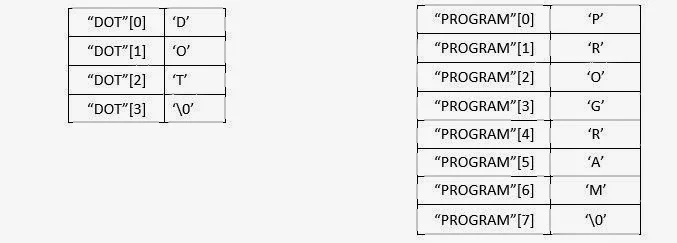There is no separate data type for strings in C language. In C language, a string is an array of characters and terminated by NULL character which is denoted by the escape sequence '0'. A NULL terminated string is the only type string defined using C language.
A string is stored as a sequence of characters in an array terminated by \0. For example, consider the string "DOTPROGRAMMING". This string is stored in the form of an array as shown below:
Note that the characters are stored from location zero. Each location holds one character string from 0 to 14. The string always ends with NULL. Character denoted by '\0'. Here, the string "DOTPROGRAMING" is called a string literal.
main()
{
clrscr();
printf("5c","DOT"[0]);
printf("5c","DOT"[1]);
printf("5c","DOT"[2]);
getch();
}
The entire string can be referred and display as shown below:
main()
{
clrscr();
printf("DOT");
getch();
}
Each of the above program will outputs "DOT" string on the monitor or any output device connected with the PC.
A string is stored as a sequence of characters in an array terminated by \0. For example, consider the string "DOTPROGRAMMING". This string is stored in the form of an array as shown below:
Note that the characters are stored from location zero. Each location holds one character string from 0 to 14. The string always ends with NULL. Character denoted by '\0'. Here, the string "DOTPROGRAMING" is called a string literal.
String Literal or Constant
A string literal or constant is a sequence of characters enclosed within double quotes. For example, "DOT PROGRAMMING", "DOT", "PROGRAMMING" are all string literals. When a string literal is defined, the C compiler does the following activities:- The compiler creates an array of characters.
- Initializes each location of array with the characters specified within double quotes in sequence.
- Null-terminates the string that is appends ‘\0’ at the end of the string. This is done by the compiler automatically.
- Stores the starting address of the string constant that can be used later. For example, the literals "DOT", and "PROGRAM" can be stored in the memory as shown below:
Referencing String Literal or Constant
An array of integers is stored in contiguous memory locations, it is clear from the above figures that a string literal is also stored in memory contiguously one after the other. So, each character of the literal or constant can be accessed using index (array or pointer concept can be used). For example, consider the following program:main()
{
clrscr();
printf("5c","DOT"[0]);
printf("5c","DOT"[1]);
printf("5c","DOT"[2]);
getch();
}
The entire string can be referred and display as shown below:
main()
{
clrscr();
printf("DOT");
getch();
}
Each of the above program will outputs "DOT" string on the monitor or any output device connected with the PC.


